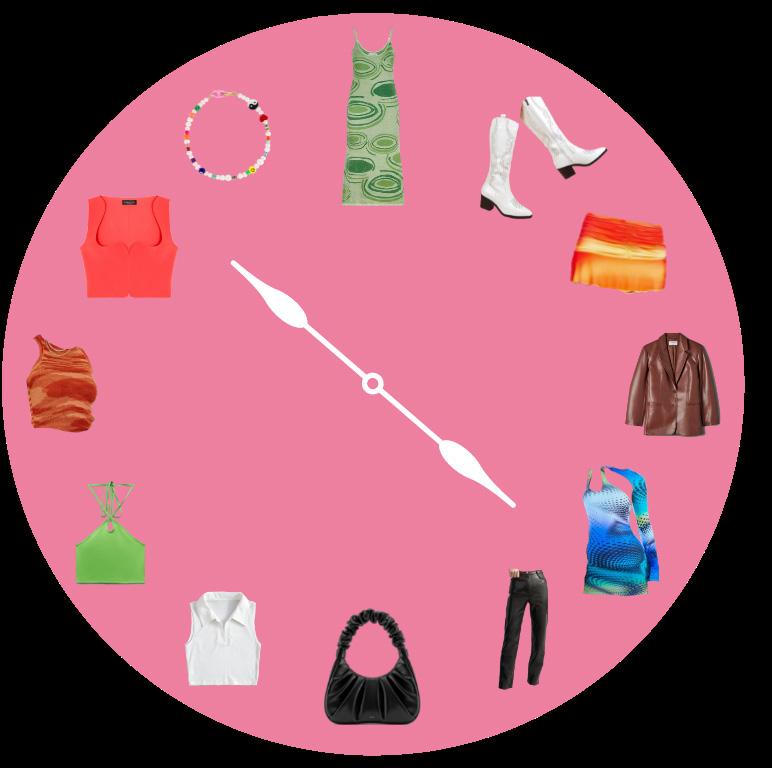
4 minute read
Tik Tok vs. Trend Cycle
If you could personify 2021 fashion in one item, what would it be? Your pick would probably range from the iconic House of Sunny Hockney Dress, a Martha Calvo necklace, or maybe a high neck crop top in a maximalist print. What do all of these have in common besides being some of the biggest microtrends of the year? They were all born, spread, and shared on social media in the form of “outfit of the day” videos, collective hauls, or from someone asking in a comment section, “OMG! I love your top, where did you get it?” TikTok, one of the biggest and most influential apps to date, has fast fashion and microtrends in a chokehold, completely dictating movement of smaller scale style discourse. These pieces all fall in and out of trend extremely quickly without actually changing the baseline of what is considered fashionable.
How this cycle continues to thrive and perpetuate unsustainable style is due to its easily replicable nature; TikTok has seemingly made fast fashion even faster. A popular creator will post in a top, most likely from a sustainable (and expensive) fashion brand. The overwhelming amount of people eyeing the piece but not being able to afford it makes it a perfect target for imitation from fast fashion companies, such as Amazon, SHEIN, and AliExpress. These companies will then list knockoffs on the top on their sites, with names such as “Women Casual Crew Neck Crop Tank Top Solid Sleeveless Vest,” with the only real differences between the original and the copycat being the quality and the price tag. With these substantial trends replacing each other every few weeks, keeping up with the fashion cycle is nearly impossible. By the time you have already received your $12 knockoff, the next popular item is already starting to gain attention.
Advertisement
This watering down of high fashion, an industry that has isolated itself as an intimidating and exclusive club that only a select few can access and control, begs the question, has the facade of fashion finally fallen? Yes and no. The long-held inaccessibility of fashion is what creates the exclusive nature that many spend their lives chasing and longing to be a part of. It is what drives people from all over the world to move to cities like New York City and Paris to begin careers as models, designers, creative directors, and more. It is what caused events such as Fashion Week and The MET Gala to rise to international prominence and recognition in pop culture. It is what dictates what is “hot” and what is “not,” what is “in” and what is “out.”
High fashion is not a narrative created by others, but in fact the narrator of all things culture, trends, fashion, and style. Think back to one of the most infamous scenes in The Devil Wears Prada. Yes, the cerulean sweater dialogue. In this scene, Miranda Priestly brilliantly explains
the “trickle-down” effect commonly witnessed in the fashion industry, and how a majority of what we buy at Zara, Aritzia, etcetera, are all direct reflections and copycats of previous runway or editorial looks. So, while the machinations of the fashion industry stay running, it is unlikely that higher end brands will cease in their ability to influence and control the narrative and direction of trends.
However, the influence that social media has on the trend cycle is a prominent threat to how the fashion industry operates in terms of production and design turnover, a significant factor in regards to over-consumption and fast fashion. Producing an item of sustainable clothing is much more complex than the immediate producer to consumer pipeline seen in other industries and fields. It entails a mood board, designing, collecting swatches and sourcing fabric, fittings, outfit trials, mass production, promotion, and physical or online distribution. The TikTok trend cycle has eliminated consumer patience, a key aspect of the process. Consumerism and instant gratification have taken its hold on younger demographics, so once they see it on their favorite influencer, they want it in their possession within the week.
Obviously, a majority of high fashion brands are not going to sacrifice their design integrity for the desires of teenagers on the Internet. However, voids in a market will continue to be filled by those willing to produce their product cheaper and quicker. This puts fast fashion brands such as SHEIN on the map for consumers, furthering their reach within the fashion industry. Simultaneously, the ever-changing nod of what is “in” and what is “out” has people placing massive orders every month, piling up in their closet before they decide to drop it off at Goodwill or throw it in the garbage. This is extremely detrimental to the environment, with the fashion industry becoming the secondbiggest consumer of water in production. According to the UN Environment Program, it is also responsible for 10% of global carbon emissions, more than all international flights and maritime shipping combined. While the statistics and consequences seem dire, there are ways individuals can push back at the unsustainable social media-fueled trend cycle. Thrift shopping, shopping on Depop, and using what’s already in your closet to create unique outfits are just a few ways to up your wardrobe sustainably. Trendy does not equate to personal style, so figure out what you love and what looks best before buying.









